If you look at this Google Maps satellite view of Lisboa that’s centered on the core older part of the city
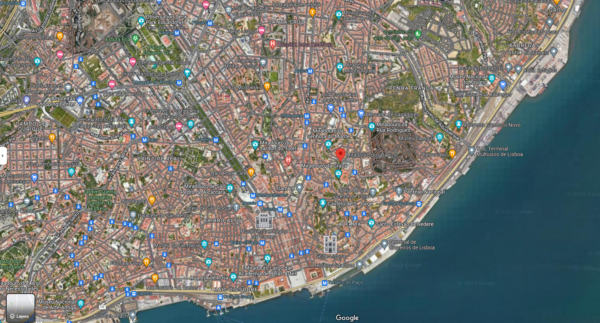
you might notice a dearth of green areas. There are some parks such as Eduardo VII (just above the Marquis de Pombal Metro) and the Jardim da Estrela to the southwest of that same metro station but these are generally relatively small. What you will notice if you enlarge the map is an abundance of miradouros or viewpoints. The bullseye on the map is at the Miradouro dos Barros toward the top of the hill I’d climb after setting out from Topo. You will also see five miradouros in close proximity and several others if you hunt about the map.
(Just to the west of this map’s view is the city’s largest green area the Parque Florestal de Monsanto named for the hills called Serra de Monsanto and nearby fort and not for the American chemical company. The park is on the western edge of the city and I can only say it’s of indeterminate size. Here’s why: According to the site lisbonlisboaportugal, “This large urban forest covers over fifty hectares…” but according to Wikipedia it’s, “the largest green patch in the city, with almost 1000 ha.” Suffice it to say, it’s a big park but it’s also some distance from the city center and a long bus {or taxi or rideshare} ride to reach.)
While few of the miradouros offer much green space, with views like this,
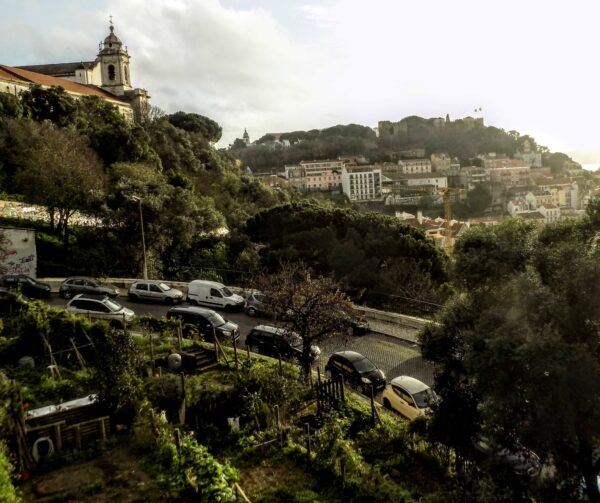
and this (even on a cloudy day),
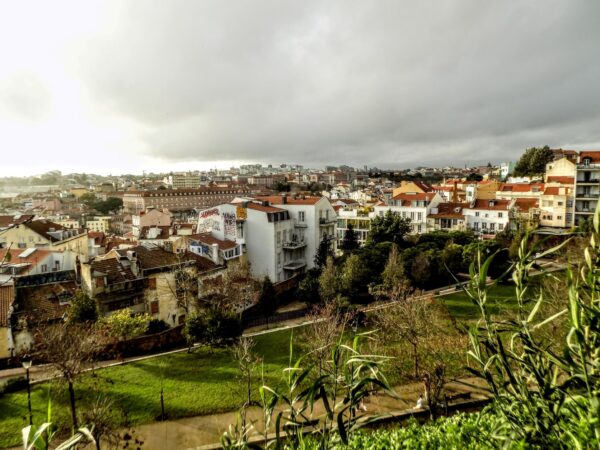
and others you’ll see either in my posts or photo albums, it’s easy to understand why both visitors and Lisboetas seek these havens. These are places to meet, savor conversation, friendship, and perhaps a light meal. Or, if you’re a solo traveler as I often am, places to find some calm time enhanced by a striking and memorable scene. Even in January, many of the viewpoints will be crowded with both tourists and locals. It’s one reason why there’s an advantage to seeking out some of the less popular spots such as the Miradouro dos Barros and its neighbor the Jardim Cerca da Graça both of which were largely unpopulated during my visit. Getting an early start to the day can be another advantage that I’ll return to in upcoming entries.
What goes up must come down.
If you recall the previous post, the ascent to reach the Miradouro dos Barros exceeded 100 meters which of course then entailed an equal descent. It was in this descent that I’d wander a bit more through Mouraria. Curiously, as I started down the hills, I discovered that I progressed more slowly than I had on the way up – a circumstance that persisted throughout my stay. On the surface, this seems counterintuitive because going up one fights gravity while going down gravity provides an assist. However in Lisboa, at least for me, while going uphill required more energy, going downhill required more focus.
You see, Lisbon’s sidewalks are often narrow cobblestone paths (even when they are wide) that aren’t always in the best repair.
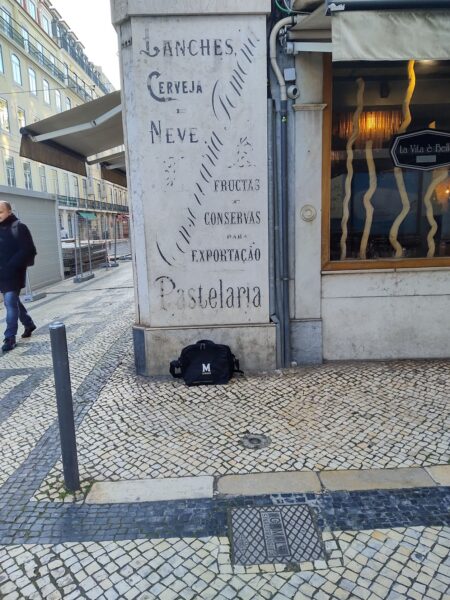
(This is one of two photos for JF of the bag in Lisboa taken near my apartment in a flat part of the city and a cobblestone walk that, although it’s uneven, is in good repair.)
Now, anyone who has spent anytime walking with me probably knows that if an object or hole is anywhere nearby, I’m likely to find it and trip. Lisbon’s sidewalks offered myriad opportunities for that to happen. And when these stones are wet, it adds additional danger. Falling on the way up is likely little more than annoying. On the way down, it’s potentially catastrophic.
It might be appropriate for you to listen to this Amalia Rodrigues performance as I wander about the streets of the neighborhood that pronounces itself the birthplace of fado:.
In a previous post, I included photos of the birthplace of Maria Severa and of the “Birthplace of Fado Monument”. In truth, I happened upon the former during this downhill amble and reached the latter very near its end.
Along the way, I came across some other interesting aspects of the neighborhood such as this side street that has not only the portrait on the house but also gives an idea of what it can be like walking downhill in Lisboa.
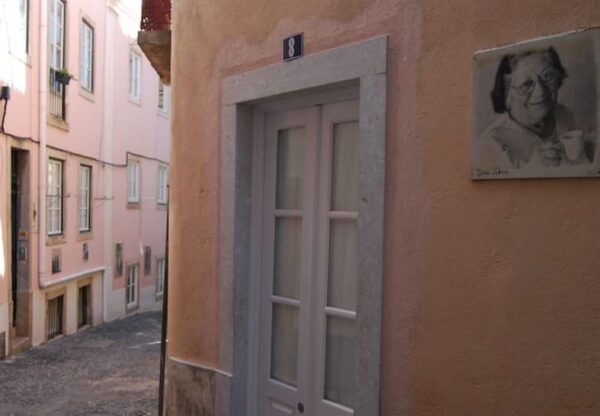
There was this interesting bit of wall art:.
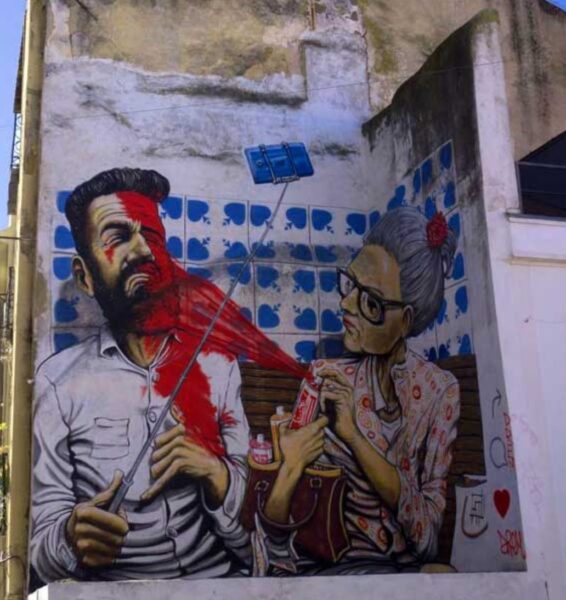
And, of course, there’s just a scene of everyday life in the Portuguese capital:.
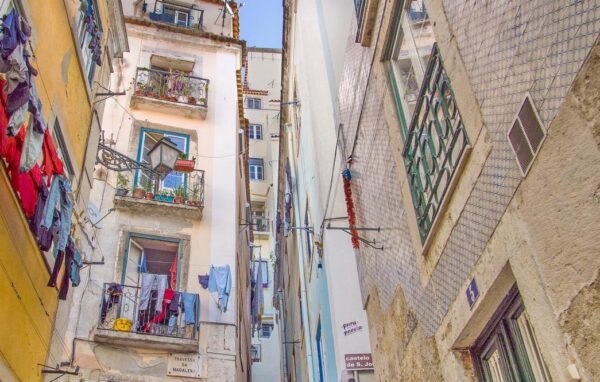
Your flat might or might not have a washing machine but if it’s in an older building or a non-gentrified section of the city, it’s certainly not going to have a dryer.
It’s Sup-sup-suppertime.
Once I decided I was through exploring Mouraria, I fired up the Organic Maps app and it led me quickly back to Praça Martim Moniz (that was, in fact quite close to the fado monument) and an easy walk back to the apartment. Martim Moniz is just a few blocks north of Praça Figueira which was the northern terminus of the street where I lived and was where the taxi had deposited me Wednesday afternoon making it quite easy to find my way once I reached the square. (In fact, one of the advantages of staying in Baixa is, that after the 1755 earthquake, the neighborhood was effectively razed and rebuilt with the streets lined up in a grid. It is, in that way, like midtown Manhattan while most of the rest of Lisboa is like downtown Manhattan with streets running off in whatever direction must have been convenient at the time.)
Although I made some effort to eat dinner later than my usual time of between 18:15 and 18:30, I certainly wasn’t ready (and never became so) to begin dinner at the more Portuguese-like time of 21:00 or so.
Before I briefly recap my dinner, I want to provide three dining out lessons you should take with you if you ever travel to Portugal. Even though the growing popularity of Portugal as a tourist destination is slowly working changes in all three, preparation is helpful.
First, be certain of the restaurant’s hours. Many restaurants in Lisboa and around the country maintain the tradition of closing in the middle of the day typically from 15:30 to 19:30. So, if you’re planning to have your dinner before 19:30, be certain the restaurant will be open.
Second, carry enough cash to pay for your meal. While more and more restaurants accept credit and debit cards many remain cash only. It can be helpful to ask but I’d suggest asking more than one person to confirm that they accept cards if you plan to charge your meal. (You also need to be aware that not all ATMs are created equal if you think that can be a resource. Any machine in the Euronet system will charge you an outlandish 10%-13% fee over and above the currency exchange rate – which you should always let your home bank calculate.)
Third is the couvert. If you sit at a table that is pre-set with a dish of olives, some cheese, and perhaps bread and butter or if the server brings it to you without asking, send it back or be prepared to see a charge for it on your bill. As with the other two, an increasing number of restaurants require you to order the couvert separately. Never expect it to be free.
As for my dinner on this night, I’d decided to return to the edge of Mouraria to try the Mozambican restaurant called Aziz. It was a bit out of the way but Organic Maps led me there easily. When I arrived at 19:30 or so, only two other tables were occupied and I felt a bit like I was part of the early-bird special crowd.
I started with the chicken chamussas

[Photo of chamussas from Restaurant Guru].
followed by a main of their signature dish – a prawn, crab, and cabbage stew in a peanut and coconut sauce called Makoufe
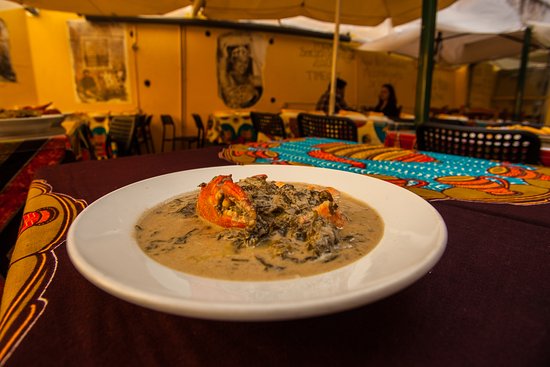
[Photo of Makoufe from Restaurant Guru].
and a beer. This delicious meal cost me a mere 20 euros.
I passed on dessert choosing instead to walk to a bakery in Chiado called Sacolinha to try their Bolas de Berlim (as recommended by the Washington Post Travel section). To reach Sacolinha, I had to negotiate the hill up Rua Garrett to the Largo do Chiado.
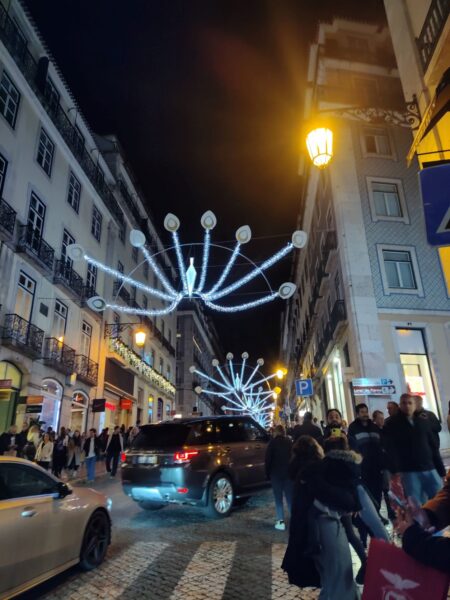
(I took this photo at about 20:30).
Bola de Berlim is the Portuguese version of the German Berliner (the jelly donut that President Kennedy once claimed to be) that replaces a dab of jelly with an overflow of custard.

[Photo of bola de Berlim By Carlos Paes from Wikimedia Commons.]
I walked back down the hill to my flat, brewed a cup of tea, savored my dessert, and went to bed after a satisfying first day in Lisboa.
Here are all the day’s photos.
Do you give extra credit if one finds more than the listed number of songs on a post?
I am considering that. Your score will be based on the songs I have deliberately included and described in the music post. I might use extras as a tiebreaker.
I am just getting started but this post didn’t disappoint! I love the picture with the laundry drying on the clothes line.
Glad to have you back! Hope you’re planning to try your mind at the music contest this time.